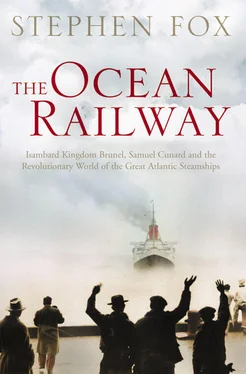The Ocean Railway
Isambard Kingdom Brunel, Samuel Cunard, and the revolutionary world of the great Atlantic steamships
Stephen Fox
To the memory of PHYLLIS RUTH BLAKELEY (1922 -1986)
Provincial archivist for Nova Scotia
Biographer of Samuel Cunard
Cover Page
Title Page The Ocean Railway Isambard Kingdom Brunel, Samuel Cunard, and the revolutionary world of the great Atlantic steamships Stephen Fox
Dedication To the memory of PHYLLIS RUTH BLAKELEY (1922 -1986) Provincial archivist for Nova Scotia Biographer of Samuel Cunard
Prologue THE NORTH ATLANTIC OCEAN AND THE BRITANNIA
PART ONE: The Packet Ship Era, 1820-1840
1. The Sailing Packets
2. Steam on Water
PART TWO: The Era of Cunard Domination, 1840-1870
3. Ships as Enterprise: Samuel Cunard of Halifax
4. Ships as Engineering: Isambard Kingdom Brunel
5. The Cunard Line
6. The Collins Line
7. Distinguished Failures
8. Emigration and the Inman Line
9. Life on a Steamer
PART THREE: The Era of Steamship Competition, 1870-1910
10. The White Star Line
11. Competition and Invention
12. Ships as Buildings: Two Cycles to Cunard
13. Ships as Towns: Officers, Crew, Steerage
14. Anglo-Americans
15. Germans
16. The Two Finest Cunarders
Notes
Index
Acknowledgments
About the Author
By the Same Author
P.S.
About the author
Q&A
Life at a Glance
Top Ten Favourite Books
About the book
A Critical Eye
The Routes of History
Read on
Have You Read?
If You Loved This,Youll Like …
Find Out More
Copyright
About the Publisher
Prologue The North Atlantic Ocean and the Britannia
From Liverpool, on the River Mersey, a ship bound for a port in the northeastern United States heads west eighty miles across the Irish Sea, and then – when clear of Holyhead – turns sharply south into St George’s Channel. The ship navigates carefully through St George’s, which funnels currents and storms from larger contiguous seas into a narrowing, unpredictable passage squeezed between England and Ireland. She moves southwesterly along the Irish coast, skirting the Old Head of Kinsale and other jutting headlands, to reach (but avoid) Cape Clear and the Fastnet Rocks at the bottom of Ireland. To this point the ship has gone about 300 miles since departing from Liverpool. From Cape Clear the ocean stretches out unimpeded to the western horizon and far beyond. Starting there, the great circle route to America arcs across nearly 3000 miles of the North Atlantic: one of the most varied, troublesome ocean voyages in the world.
Over its entire course, the great circle route veers gradually southwards from fifty-three to forty degrees north latitude. Giant spirals of wind and weather gust far above and perpendicular to the ocean’s surface, rotating across twenty or more degrees of latitude in counterclockwise systems that generally hit the great circle to America in the southern half of their spins. Prevailing winds in that stretch of ocean therefore come from the west and southwest, fighting any westbound ship. The weather is typically unsettled, with odd, sudden shifts in temperature, pressure, wind speed and direction. Systems collide and combine and bouncearound. Long, high, stately deepwater waves march along over hundreds of miles of ocean. On occasion, several wave components may converge momentarily, producing a rogue wavemuch bigger than any of its parts – up to four times the height of an average North Atlantic wave, sometimes even 100 feet high or more.
The weather, seldom agreeable, turns worse in winter. From October to March, the days are cold, short and dark, the sun low in the sky, the sea a turbulent dark grey. At mid-ocean, abrupt winter galesmay quickly reach speeds of sixty-five knots, with steep waves of 40 to 60 feet and smaller combers curling out in extended cycles up to 400 feet from crest to crest. White flecks – from spindrift and foam atop the breaking waves – stand out in sharp relief against the slates of sea and sky: the natural world pared down to stark monochromes of grey and white, pretty but indifferent in its muted danger.
Towards the end of the voyage, well over 2000 miles from Liverpool – just as crews may be growing tired and irritable, with flagging attention and potential lapses in discipline, and passengers bored or restive, and food or fuel perhaps running low – the ship enters the notorious graveyard of the North Atlantic. This most hazardous sector of the great circle is encountered precisely when the ship’s company may already be stretched tight and vulnerable.
Here the winter gale season yields, with no relief, to iceberg season, which generally starts in January and then peaks from April to July. Far to the north, in the west of Greenland, glaciers flow down the coastal mountains to the sea, annually calving thousands of icebergsinto the Davis Strait. The bergs float slowly southwards in the Labrador Current. At unpredictable times in the following year, the surviving remnants – about four hundred icebergs each season – reach the shipping lanes off Newfoundland. A typical splinter or castle berg weighs over 100,000 tons and stands about 150 feet high by 300 feet long, above water; in extraordinary cases both dimensions may be doubled and more. Smaller bergs, growlers, field ice and floes can pose more hidden danger to ships: lower in profile, sometimes barely above the ocean surface, they are harder to see and avoid. When a ship enters the iceberg zone, temperatures dip and the air smells different, and lookouts get edgy.
The icebergs further trouble the tumultuous Gulf Stream. The strongest of all ocean circulations, and one of the most startling, mysterious discoveries made by the early European explorers of the New World, the Gulf Stream was first charted by Benjamin Franklin in 1769. Trade winds pile up water along the continental edge of South America nearpagethe equator and send it ‘downhill’ through the quickening channel between Cuba and the Florida Keys. The stream then runs up the eastern seaboard of the United States, thirty to fifty miles wide, at two to six miles an hour. Its warm water and rapid course inhibit the growth of phytoplankton, creating a vivid swath of deep, clear, pure blue against the greener, greyer surrounding ocean. Off the North Carolina coast, it divides into smaller substreams, which loop and meander. Even so, when the Gulf Stream reaches the area south of Nova Scotia, it is still moving over 150 million cubic metres of water each second – some 10,000 times the volume of the Mississippi River.
East of the Grand Banks of Newfoundland, and squarely athwart the great circle route to America, the warm Gulf Stream collides with the cold Labrador Current, producing the most extreme temperature differences in any ocean. This volatile mix has vast consequences in the air and water. Some are even whimsical (icebergs spinningslowly on their vertical axes, like huge, silent, snowy carousels). Most are more serious: mists, gales, squalls, driving rain and churning waves. At its worst, the atmospheric mingling of cold Canadian air and warm, moist Gulf Stream air may generate the sudden winter hurricanes called bombs, or rapidly intensifying cyclones. An abrupt drop in atmospheric pressure at the centre of a comma-shaped cloud mass, usually in January or February, can unpredictably generate winds of hurricane force. With little warning, the bomb just explodes.
The most widespread result of this massive convergence of cold and warmth is dense, persistent fogs. Off Cape Race, at the southeastern tip of Newfoundland, from April to September at least twelve days of every month are shrouded in sea fog. At midsummer it is nearly constant. ‘ These horrid fogsinfest the air most part of the year,’ the English hydrographer John Purdy noted in 1817, ‘and will last eight or ten days successively, sometimes longer.’ The fogs can assume geometric, hedgelike forms, with vertical slabs at their eastern edges squared off by long, level top layers. An observer may watch a ship emerging slowly from one of these banks, revealing herself in sharply defined foot by foot, as though being dragged out of a grey cliff at the water’s edge.
Читать дальше












